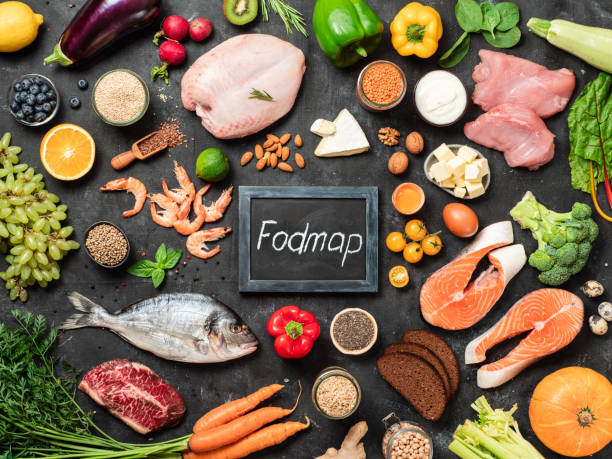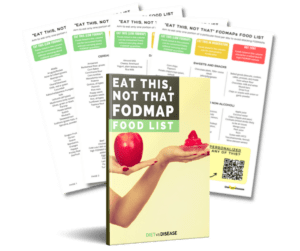Are you dealing with persistent digestive issues and wondering how to do a low FODMAP diet properly?
This is one of the most common questions we get at Diet vs. Disease, and if you’re tired of spending all your free time trying to figure out digestive relief on your own, this article is exactly what you need.
We’re going to cover everything you need to start a low FODMAP diet successfully, so you can get through it as smoothly as possible, find relief from symptoms, and one day eat with freedom like a normal person again.
Here is a video we made, otherwise there is a written version underneath.
What Are FODMAPs?
FODMAPs are a type of carbohydrate we eat that, if poorly digested, cause symptoms in those who are sensitive.
The FODMAP acronym stands for:
- Fermentable (meaning they are broken down and fermented by the bacteria in the large bowel)
- Oligosaccharides
- Disaccharides
- Monosaccharides
- Polyols
Now here’s the mechanism you need to understand about why FODMAPs cause symptoms:
When these FODMAPs are poorly digested, they ferment in the lower part of your large intestine—your bowel or gut. This fermentation process draws in water and produces carbon dioxide, hydrogen, and sometimes methane gas.

This causes the intestines to stretch and expand, resulting in:
- Strong abdominal pain
- Bloating
- Visible distension in the abdomen
Think of it like this process:
- You eat food containing FODMAPs
- Small intestine reaction – Some FODMAPs may pull water into the small intestine, potentially causing diarrhea
- Large intestine issues – In those with IBS, FODMAPs travel to the large intestine largely undigested
- Bacterial fermentation – Certain bacteria interact with those undigested FODMAPs, causing the major symptoms like bloating, gas, and pain
Summary: FODMAPs are fermentable carbohydrates that cause digestive symptoms when poorly digested in sensitive individuals. When these compounds reach your large intestine undigested, they ferment and draw water into the gut while producing gases. Which then causes the intestines to stretch and expand, resulting in the painful bloating, gas, and visible abdominal distension that characterizes IBS symptoms.
What Is a Low FODMAP Diet?
A low FODMAP diet (also known as a FODMAP Elimination Diet) is a temporary eating pattern that, as the name suggests, is very low in FODMAPs.
Primary uses:
- Relieve symptoms in those with IBS
- Emerging treatment for ulcerative colitis, microscopic colitis, diverticulitis, SIBO, and more
- Now, the widely recognized first-line treatment for IBS patients
Important clarification: A low FODMAP diet is very restrictive. It cuts out numerous common foods and food groups—and therefore nutrients. That means you need to reintroduce foods at some stage. It cannot be a permanent solution to stay in this elimination phase.
Summary: A low FODMAP diet is a temporary, highly restrictive eating pattern designed to minimize exposure to fermentable carbohydrates that trigger digestive symptoms.
The 3 Phases: How the Low FODMAP Diet Actually Works
Most people think there are two phases, but there are actually three crucial phases:
Phase 1: Elimination (3-8 weeks)
So for 3 to 8 weeks (depending on how you respond), you strictly exclude all high FODMAP foods from your diet with the goal of minimizing your exposure to FODMAPs and getting basically symptom-free.
Phase 2: Reintroduction/Rechallenge Phase

Then, you reintroduce each FODMAP group one at a time to see what triggers symptoms, and you do it at an increasingly higher dose.
For example, you may first reintroduce lactose with a small portion of milk, and if there’s no reaction, you would increase it the next day, and so on. And once that is done, you move to the next group — like reintroducing fructose.
Phase 3: Maintenance Phase
Once trigger FODMAPs have been identified, you’ll know what you can and cannot tolerate and in what quantities. You can then formulate your own personalized eating pattern that allows you to eat a wide range of foods without symptoms.
Summary: The low FODMAP diet is a structured three-phase process that many misunderstand as only having two phases. After eliminating high FODMAP foods to relieve symptoms, you gradually reintroduce them to identify your personal triggers. The final phase is all about creating a personalized, balanced eating plan that gives you symptom-free food freedom.
Would you also like help navigating your food triggers?
Tap the blue button below to download our “Eat This, Not That” list as well as additional resources for SIBO (it’s free!)

How to Do a Low FODMAP Diet Successfully
As you can see, the low FODMAP diet is not necessarily easy—but it is simple, if you follow the process correctly.
Important note: This diet has only ever been evaluated as a dietitian-delivered diet. There aren’t published studies showing it works when patients do it alone. For this reason, it’s recommended to do this under the guidance of a knowledgeable dietitian where possible.
That said, if you need to attempt this on your own, here’s what you must do:
Step 1: Get the Right Mindset and Resources
You must be highly motivated and disciplined to do this yourself without professional guidance or accountability. This is going to require commitment.
Download the Monash University FODMAP app. Monash is the world’s leading source of FODMAP research from Melbourne, Australia, where all the research started. The app is worth every penny and has a searchable database of foods.
Step 2: Use Smart Food Swapping Strategy
Get a comprehensive food list so you can see what foods you typically eat that are high in FODMAPs and swap them for low FODMAP alternatives.
The smartest approach: Rather than following a whole new meal plan, modify what you and your family already eat to be low FODMAP versions of those meals instead.

Step 3: Document Everything Systematically
This diet is a process, so you need to be systematic. You need to document:
- What you ate
- The quantities
- When you ate them
- Any symptoms you experienced
Think of this as a food and symptom journal. This is fundamental—you can write it down or use an app, but you must track everything.
Why? Because you can’t spot patterns and trends on a blank page. You need to connect the dots: “This is what I ate here… and these are the symptoms I experienced.” Without documentation, you can’t make progress.
Summary: The low FODMAP diet should be done with a dietitian’s guidance. Using the Monash FODMAP app, adjusting your usual meals, and keeping detailed food and symptom logs are key to making it work. That tracking is what helps you connect the dots and uncover your unique triggers.
What Should You Do Next?
If you’re tired of dealing with persistent digestive issues and suspect FODMAPs might be a trigger, don’t keep guessing.
The low FODMAP diet can be highly effective—studies show it works for up to 86% of people with IBS—but it requires the right approach, proper resources, and systematic execution.
If you want to learn more about how we might be able to help you, I invite you to apply for a nutrition assessment call with us.

I need to try the FODMAP diet per my MD due to SIBO. Although I will schedule with a dietician I wish to get started asap. I have already requested a food list and I know it is said to modify original diet but are there any samples of the diet so that i can get some ideas for meals. I have also tested with high sensitivity to dairy(not just lactose)so need to take all of this into consideration. Thank you if you have any other materials I can down load
It’s amazing how all are connected to a healthy gut.
I was excited to find your website. I tried to download your Eat This/ Not that list but kept getting an error message. When you respond can you send me a downloadable copy?
Hi there! Sorry to hear there was an error. Here’s the link to our FODMAP food list: https://www.dietvsdisease.com/fodmap-food-list